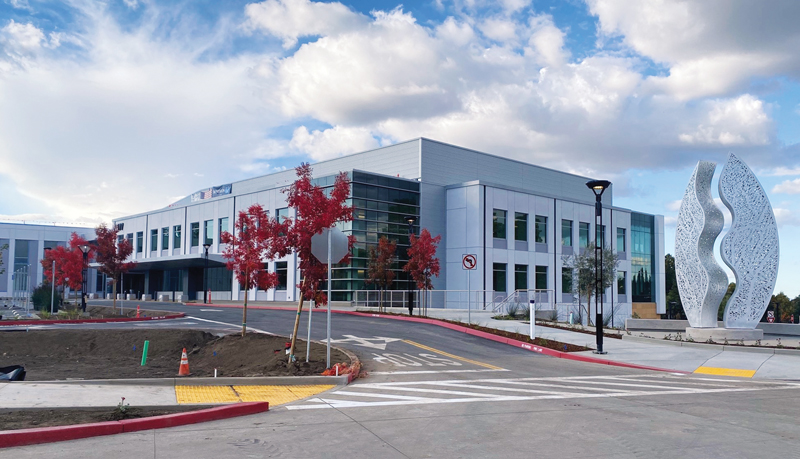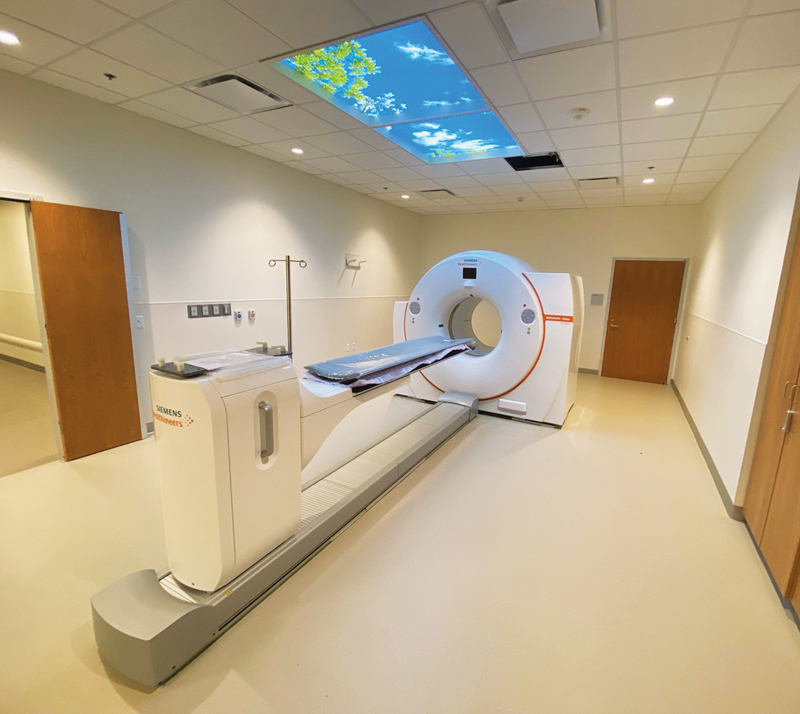Cutting-edge treatment hub debuts in 2024 as John Muir’s $300 million Behring Pavilion opens

WALNUT CREEK, CA (Dec. 6, 2023) — A bigger and better platform to fight cancer is ahead in 2024, with a consolidation of services under one roof on the grounds of John Muir Health’s Walnut Creek Medical Center.
The biggest shift to the $300 million, multi-faceted, 155,000 sq. ft. three-story facility will come with transferring operations from the California Cancer & Research Institute along Taylor Boulevard in Pleasant Hill.
While four medical oncologists were on staff when it opened in 2008 as Diablo Valley Oncology, there are now 13 under John Muir Cancer Services.
The new facility, dubbed the Behring Pavilion, is nearing completion after breaking ground in 2021. It will be home to the newly named UCSF-John Muir Health Jean and Ken Hofmann Cancer Center.
The new digs and the health system’s Campaign to Conquer Cancer gained notable financial boosts as 2023 came to a close with donations of $20 million from the Behring Global Educational Foundation and $25 million from the Hofmann Family Foundation.
“(The Hofman Family Foundation’s) transformative gift will allow us to create a center of excellence where patients receive exceptional care, groundbreaking research thrives and a sense of optimism pervades everyone affected by cancer,” said Mike Thomas, president and CEO of John Muir Health.
Multidisciplinary approach
The facility’s February 2024 opening will bring cancer prevention, diagnosis, treatment and care coordination into one facility where multidisciplinary teams comprised of top cancer specialists will be working for patients as part of the UCSF-John Muir Health Cancer Network. Without traveling to San Francisco, patients will have access to clinical trials and receive extensive support through nurse navigator and survivorship programs, genetic counseling, cancer nutrition and more.
“Working with UCSF gives access to a commitment that has never been there before,” said Dr. Tiffany Svahn, medical director of oncology for John Muir Health and president of the John Muir Health Cancer Medical Group.
The new facility comes amid rising cancer rates further complicated by an aging population. It’s all the more challenging as doctors see an increase in cancer in younger people, “which is a disturbing trend,” lamented Svahn.
Juxtaposing that bleak outlook is a bright and optimistic future for patients and their loved ones that is made possible by the arrival of the state-of-the-art facility. The third floor, awash in light, offers patients receiving infusion care wonderful views of Mount Diablo. At any one time, the facility can care for 58 chemo patients.
The building is also outfitted with radiation oncology and imaging components. Rooms equipped with three radiation linear accelerators, with space available for a fourth, along with imaging space devoted to MRI, CT and PET scan services are additional hallmarks.
In keeping with the one-stop convenience, patients will be able to complete labs and get prescriptions filled before leaving the Pavilion. And, patients and their loved ones can enter a healing garden for silent medication and reflection.
New resources for patients

While some satellite offices will stay open, such as ones near Rossmoor and in San Ramon and Vallejo with limited offerings, the new facility will be where all the action is centered going forward. This includes consolidating two medical radiation oncology groups into one larger group with an increasing staff.
Another notable improvement will be the role of patient care coordinators who hold the hands of cancer patients in early days of their diagnosis and nurse navigators as the arduous journey proceeds. That staff will increase to correspond with the greater level of care being provided through the new facility.
Martinez resident Ericka Hickle, 39, who underwent treatment for breast cancer at the Taylor site, marveled at the care she received in the intimate surroundings.
“They work miracles with it,” she said of the tight quarters. “I am so grateful for them, truly.”
Having just wrapped up her treatments, Hickle will have periodic follow-ups at the new facility. While she isn’t concerned about the drive to Walnut Creek, she said parking will be “the biggest issue.”
But John Muir spokesperson Ben Drew said such concerns are being addressed. Folks approaching the new Walnut Creek facility from Ygnacio Valley Road may not see the acres of parking beyond it. Also, the current parking structure that serves the hospital is slated to be reconfigured so doctors park on the upper two floors and patients use floors 1-3.
Acknowledging there will be bumps in the road, Drew said: “We are putting patients first.”
A strategy moving forward
According to Svahn, the new facility will redefine the standard of cancer care locally.
“There is nothing near us with a cancer center of this magnitude,” she said. “Now we have a higher level of cancer care, and it is right in our backyard.”
Yet there is still room for growth, and financial resources are in place to support even more services and programming.
“We will just keep adding. I think it is just the tip of the iceberg,” said Svahn, citing increasing resources to tackle breast cancer along with multiple other types, including prostate, colon and lung.
In doing so, she reinforced, they will maintain a “family feel.”
“We want to hold on to the smallness, that warmth,” said Svahn, hoping that patients “feel they will get the best of both worlds.”

David Scholz
David Scholz is back in journalism as a freelance writer and photographer after nearly two decades in education. Prior to moving into teaching in 2000, he worked as a full-time journalist since 1988 for rural community and small daily newspapers in Central Ohio and Northern Nevada, and later in California with The Business Journal in Fresno and dailies in the Bay Area, including The Oakland Tribune and The San Francisco Chronicle. More recently Scholz also worked in an editing, writing, and page layout role with the Rossmoor News.
